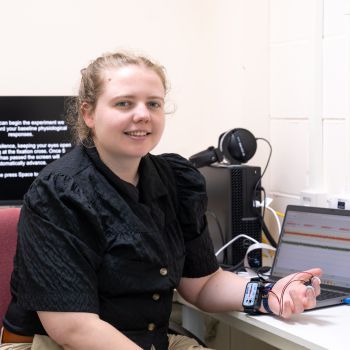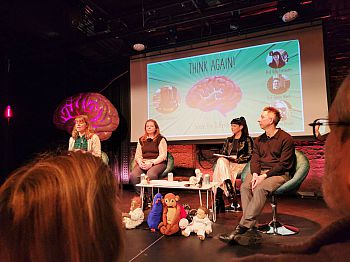Broadcast: News items
Spotlight on Researchers: Dr Louisa Rinaldi
Posted on behalf of: Sussex Researcher School
Last updated: Monday, 1 September 2025

The Journey into Research
I fell into my research career by accident! At the end of every academic stage, people would ask what I wanted to go on to do. Since I never knew the answer and I liked studying, I delayed making a decision for as long as possible by doing more studying.
After my MSc in Clinical Cognitive Neuroscience at Sheffield Hallam University, I felt like I was well set up for one of two pathways forward: one was to pursue a clinical career and the other was to do a PhD and pursue a research career. I choose the latter, and never looked back!
I was interested in the various ways in which we perceive the world differently from one another without generally realising. This was particularly highlighted one day when watching a documentary with my family about synaesthesia. Synaesthesia is when people associate music or letters as having particular colours. My dad looked up in confusion during the documentary and said “but everyone does that, don’t they?” and, upon looking at my mine and my mum’s faces, soon learned that in fact not everyone thought that letters had colours.
Due to fortuitous timing, when I decided to pursue a PhD, I found an advertisement for studying the development of synaesthesia in childhood at Sussex University. This was the first step on my journey towards pursuing my own research interests around sensory perception.
The Research
My field of research is sensory diversity, specifically looking at different populations that have unique sensory perception. This includes synaesthesia, misophonia, where people find certain sounds like chewing unbearable, and aphantasia, where people are not able to create pictures in their mind’s eye.

In my PhD I looked at the development of synaesthesia during childhood, forming part of a team that tested 3,500 children! This was the largest cohort study of childhood synaesthesia, testing children across 22 primary schools around Sussex. We tested to identify those with grapheme-colour synaesthesia, where letters and numbers have specific colours that remain consistent. This variant of synaesthesia only occurs in around 1% of the population, meaning we had to screen a large number of children to find just a few with this variant. My PhD explored how children with synaesthesia differed from those without synaesthesia in other areas, including their personality and academic skills.
As a post-doctoral fellow, I’ve been more focused on people with misophonia. Previously, my work has showed that people with misophonia suffer from increased levels of anxiety, depression, and self-harm. At the moment I’m working as a researcher on a Misophonia Research Fund grant. We’re running a clinical trial to investigate whether a non-invasive device, which gives transcutaneous vagus nerve stimulation, can help reduce people’s misophonic experiences so that they are not as affected by sounds. We hope that we might be able to help reduce the impact of misophonia on people’s everyday lives and improve their overall quality of life.

Throughout my different areas of sensory diversity, one of the key things I have been interested in is impact on wellbeing. If we can better understand people’s experiences across a spectrum of sensory sensitivities, we may be able to develop interventions to support better mental health and wellbeing, for both children and adults. We have already created resources based on our research for synaesthesia (syntoolkit.org) and misophonia (misophonia-hub.org) to support parents, teachers, and people with the condition.
One of the main challenges in this field is that I’m often looking at conditions which only affect small percentages of the general population. This means that we have to be careful to get large enough samples to ensure we have sufficient statistical power. It also means it can be hard to look at how the conditions we are interested in interact due to small sample sizes. It’s very important to me that not only is my research robust, but that I accurately represent the experiences of understudied groups.
Due to time and budget demands, I generally have to rely on people with the condition to come forward and this can cause biases. Research shows that certain people are more likely to come forward to take part in research. For example, women are more likely to take part in research than men. These kind of methodological implications can have a major impact about what we can learn, or assume, about a particular group of people, so rigour is essential.
Achievements and the Future
This year I won a Researcher-Led Initiate Fund award to run the project Empowering Excellence: Unlocking Prizes, and the ‘Research for the Greater Good’. I jointly won this award with Emily Whelan, a postgraduate researcher (PGR). We created a workshop to educate PGRs and early career researchers (ECRs) in Psychology about the importance of winning prizes. The session covered why prizes are important to academic careers, where to find them, and how to write a good application. We also hosted our own prize to give our attendees the opportunity to put their new skills into practice.
 I was part of the first ever Women’s Leadership Academy this year. I received funding from the sandpit fund associated with the academy along with Dr Samira Bouyagoub, Dr Aline Amorim Graf, and Dr Jeongeun Park to run a project called "Leaps in science: Inspiring Journeys in Research and Industry". We will run two events in November to improve knowledge about diverse career paths.
I was part of the first ever Women’s Leadership Academy this year. I received funding from the sandpit fund associated with the academy along with Dr Samira Bouyagoub, Dr Aline Amorim Graf, and Dr Jeongeun Park to run a project called "Leaps in science: Inspiring Journeys in Research and Industry". We will run two events in November to improve knowledge about diverse career paths.
I’m really excited about the new paper I wrote, alongside a colleague, called The Sensory Framework. In this paper I pulled together all of the threads of sensory diversity to form a framework. With this in place I can now anchor my research going forward with this underlying framework.
I’m next looking at establishing myself as an independent researcher and setting up my own research lab. I hope in my career I am able to continue my work on sensory diversity. I am particularly interested in using mixed methods including quantitative, physiological and neural to better understand, and inform a larger picture of sensory diversity and perception.
Interview by Shona Clements, Sussex Researcher School
Are you an ECR and like to be featured in the series?
If so Apply Here

